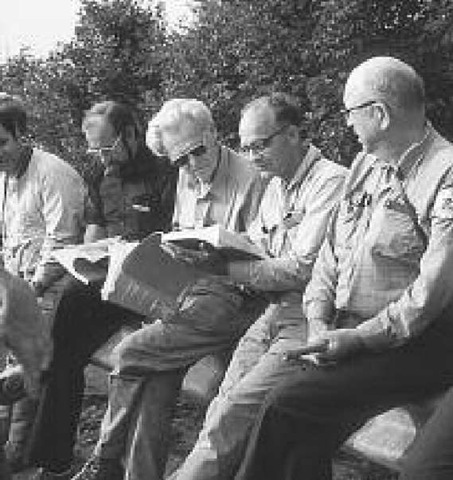(1914- ) American Field-Regional Geologist
John Rodgers collects mountain ranges. This means that he reads the literature, talks to the geologists working in the area, and takes extensive field trips through the mountains. There are very few, if any, mountains that he has not visited. He can be considered the “grandfather of regional tectonics” for this reason. Although he considers himself a synthesizer of information rather than an innovator, few would agree with that evaluation. His experience gives him the unique ability to evaluate the comparative anatomy of mountain belts. He can visit any field area and put those rocks into the perspective of many other similar or contrasting areas. This vision has guided many researchers to better solutions of their work. His work has elucidated the commonalities and variations in the mountain building process especially with regard to fold and thrust belts. Thus there is a baseline from which other observations may be compared. Two of his more recent papers include, “Fold and Thrust Belts in Sedimentary Rocks Part 1: Typical Examples” and “Fold and Thrust Belts in Sedimentary Rocks Part 2: Other Examples, Especially Variants.”
John Rodgers’s first and primary interest has been the Appalachian Mountains of eastern North America, especially those in New England. He has mostly concentrated on the stratigraphy and structure of the sedimentary rocks, but he is quite comfortable in the metamorphic rocks as well. He wrote a seminal work on the Taconic orogen early in his career but considered the whole Appalachian orogen in his book, The Tectonics of the Appalachians. It was at that time that he was in an open controversy over whether the crystalline rocks of the continental basement were involved in the deformation of the sedimentary cover sequence. Rodgers maintained that the basement was not involved, supporting a “thin-skinned” model. He prevailed in the controversy and was proven correct as more and more data were presented. Even through the many years and numerous mountain belts, Rodgers has maintained a strong interest in the building of the Appalachians.
John Rodgers was born on July 11, 1914, in Albany, New York. After graduating cum laude and valedictorian of his class at Albany Academy, New York, he attended Cornell University, New York, where he earned a bachelor of arts degree and a master of science degree in geology in 1936 and 1937, respectively. He earned his doctoral degree from Yale University in 1944 in geology. His graduate studies were interrupted from 1939 to 1946, when he worked for the U.S. Geological Survey as a scientific consultant to the U.S. Army Corps of Engineers during World War II. He helped plan the invasion of Okinawa, Japan, using his geologic knowledge of beaches. In addition, he was instrumental in evaluating the natural resources of Japan. He joined the faculty at Yale University in 1946 and remained there for the rest of his career. He became the Benjamin Silliman Professor of Geology in 1962 and retired to an emeritus professor position in 1985. John Rodgers is an accomplished pianist and an aficionado of classical music. He also enjoys the study of foreign languages and history.
John Rodgers is one of the most influential and respected geologists of all time. Many of the papers and books that he has written are true classics that are studied worldwide. He has also mentored some of the leading structural and tectonic geologists in the world, further extending his influence. This productivity has been well recognized in the profession in terms of honors and awards. He was awarded the Medal of Freedom by the U.S. Army in 1947 for his contributions to the war effort. He is a member of the National Academy of Sciences and the American Academy of Arts and Sciences. The Geological Society of America recognized his achievements by awarding him the Penrose Medal in 1981 and the Structural Geology and Tectonics Division Career Contribution Award in 1989. He was awarded the Gaudry Prize from the Geological Society of France in 1987 and the Fourmanier Medal from the Royal Academy of Science, Fine Arts and Letters of Belgium in 1987. He was a Guggenheim Fellow in 1973-1974 and a National Academy of the Sciences Exchange Scholar with the USSR in 1967.
John Rodgers (third from left) on a field trip for the International Geological Correlation Project (IGCP) in the northern Appalachians in 1979
John Rodgers has performed more service to the profession than can be listed here. He was the president of the Geological Society of America in 1970 after having served on many committees. He was the secretary of the Commission on Stratigraphy for the International Geological Congress from 1952 to 1960, and the vice president for the Societe Geologique de France in 1960. He was an associate editor for the American Journal of Science in 1948 to 1954 at which time he became editor, which he has been ever since.

